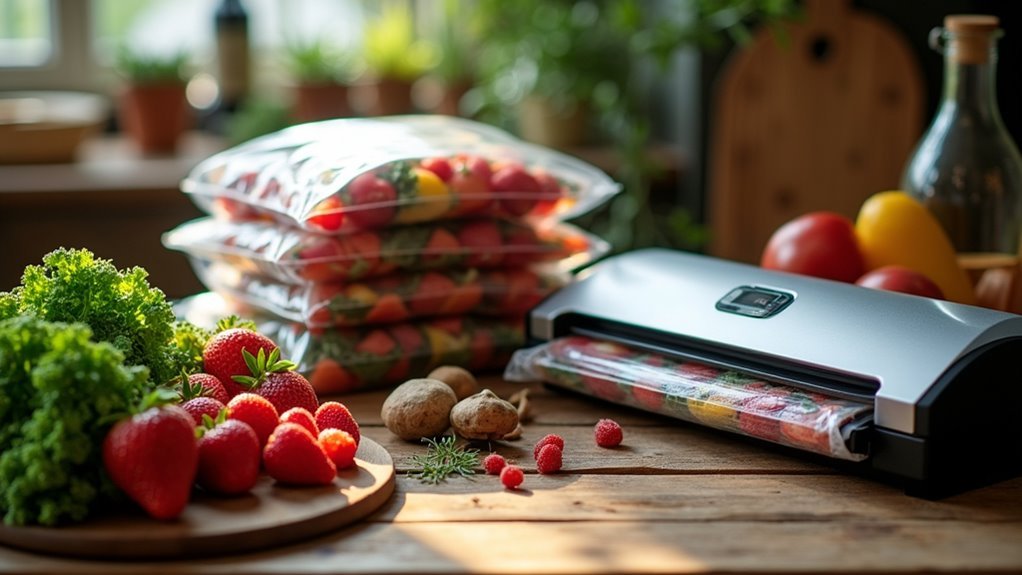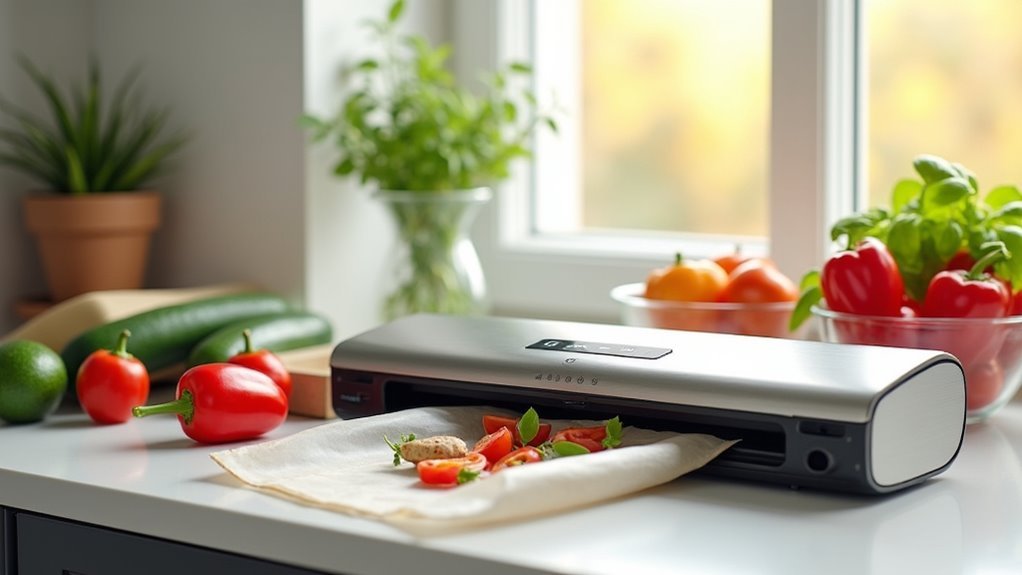Vacuum sealing revolutionizes food storage by removing oxygen that causes spoilage but, did you know that we can extend shelf life up to four times using the right techniques! Meats last years when properly sealed and frozen, while fruits and vegetables stay fresh 2-3 times longer. For best results, dry foods thoroughly, blanch vegetables first, and pre-freeze liquids. Different foods need different approaches—mastering these specialized methods will transform how you preserve everything from delicate berries to hearty roasts.
The Science of Oxygen Removal and Food Preservation

While many of us take for granted the simple act of storing our food, there's actually fascinating science happening inside that vacuum-sealed bag. The food preservation technique of removing oxygen creates an environment where spoilage simply can't thrive.
When we use a high-quality vacuum sealer, we're fundamentally stopping time for our foods. By eliminating air exposure, we're preventing oxidation—the same process that causes apples to brown and meat to deteriorate.
This lack of oxygen inhibits aerobic bacteria growth and slows enzymatic reactions that lead to food spoilage. Vacuum sealing technology has been shown to preserve nutrients effectively, ensuring that we maintain the health benefits of our foods even during extended storage.
We've seen remarkable results: vacuum-sealed meats last up to four times longer in the freezer without freezer burn, while fruits and vegetables maintain their nutritional value and foods freshness two to three times longer than conventional storage.
Specialized Techniques for Different Food Categories
Now that we grasp the science behind vacuum sealing, let's explore how to apply these principles to specific foods in our kitchens.
When preserving meats, vacuum-sealed bags can extend shelf life dramatically—beef lasts up to 1-2 years compared to just 6 months in regular storage! For fish, you'll maintain quality for two years rather than months.
Don't forget your produce: vacuum sealing fruits and vegetables triples their freshness by inhibiting mold growth. For best results with veggies, we recommend blanching first to halt enzyme activity and lock in nutrients.
Cheese and other dairy products benefit tremendously too, with freshness extending from days to weeks.
And those bulk purchases and meal prepping efforts? They'll pay off when your cooked foods and leftovers maintain flavor and texture for extended periods, reducing waste and saving money. Additionally, good vacuum sealers effectively remove air, providing optimal conditions for long-term storage, ensuring that food safety and convenience go hand in hand with these specialized techniques!
Equipment Selection for Optimal Sealing Results

The heart of successful food preservation lies in selecting the right vacuum sealer for your unique needs.
We recommend external vacuum sealers for home kitchens—they're affordable and perfect for extending food freshness. For commercial needs, chamber sealers deliver more power when removing air from perishable items.
Look for models featuring adjustable suction power, which is vital when sealing delicate foods without crushing them. Your sealer should be compatible with various bag types, including textured options for moist items and clear bags for easy identification. Choose bags that are at least 3-4 mil thick, food-grade, and BPA-free for ideal sealing results.
Don't overlook machines with an accessory port—this handy feature connects to vacuum canisters, expanding your storage methods beyond basic bags and rolls! Additionally, reliable sealing performance ensures uniform airtight seals, which is essential for preserving food longevity.
Preparing Foods to Maximize Vacuum Sealer Effectiveness
Proper food preparation stands as the foundation of successful vacuum sealing, transforming good results into exceptional ones. We can't overstate how critical it's to clean and thoroughly dry your items before sealing—removing surface moisture prevents bacterial growth and extends shelf life considerably.
When preparing foods for vacuum sealing, portion them into meal-sized quantities. This smart approach minimizes repeated unsealing and helps maintain freshness longer. For soups and sauces, freeze them solid first to enhance sealing efficiency and prevent messy spills.
Don't skip blanching your vegetables! This quick process stops enzyme activity, preserving color, flavor, and nutrients. Additionally, effective preparation ensures that food quality is preserved, contributing to extending shelf life and reducing food waste.
Before the final seal, pat items with paper towels to absorb any remaining moisture—your vacuum sealer will create a tighter, more effective seal.
Storage Duration Extension Through Advanced Sealing Methods

Moving beyond preparation fundamentals, we've discovered that advanced sealing methods greatly extend food storage duration—often by months or even years.
The complete removal of air through vacuum sealing creates an environment where bacteria can't thrive, helping to extend shelf life while preserving freshness and nutritional value of various food types.
Here's how different foods benefit from these ideal storage techniques:
- Meats and Fish - Vacuum-sealed proteins can last up to 2 years frozen compared to just 6 months in regular packaging, perfect for bulk shopping.
- Produce - Fruits and vegetables stay fresh 2-3 times longer, substantially reducing food waste.
- Dairy and Prepared Meals - Cheeses resist mold for weeks instead of days, while sealed leftovers make meal planning easier and more efficient.
Additionally, vacuum sealing helps preserve the nutritional value of vegetarian ingredients by protecting essential vitamins and minerals from degradation.
Frequently Asked Questions
Does Vacuum Sealing Increase Shelf Life?
We've seen steaks stay fresh for years! Vacuum sealing benefits food by extending shelf life dramatically through air removal importance, which reduces bacterial growth and preserves nutrients longer than conventional packaging options.
How to Extend the Shelf Life of Food Products?
We've found that extending food shelf life requires proper vacuum techniques, temperature control, and moisture reduction. We recommend airtight packaging solutions, quality ingredient selection, and proven preservation methods for ideal food freshness.
What Are the Two Methods of Preservation That Can Be Used to Extend the Shelf Life of Ambient Foods?
Just when you thought all food must perish quickly... we've found vacuum sealing and canning techniques are the two primary preservation methods that dramatically extend ambient food shelf life while maintaining nutritional quality.
What Additives Increase Shelf Life of Food?
We use preservative agents like salt brine, vinegar infusion, and chemical additives to extend food's shelf life. Natural antioxidants, sugar solutions, citric acid, herbal extracts, modified atmosphere, and fermentation process also effectively preserve foods.
